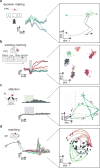Structure in neural population recordings: an expected byproduct of simpler phenomena?
- PMID: 28783140
- PMCID: PMC5577566
- DOI: 10.1038/nn.4617
Structure in neural population recordings: an expected byproduct of simpler phenomena?
Abstract
Neuroscientists increasingly analyze the joint activity of multineuron recordings to identify population-level structures believed to be significant and scientifically novel. Claims of significant population structure support hypotheses in many brain areas. However, these claims require first investigating the possibility that the population structure in question is an expected byproduct of simpler features known to exist in data. Classically, this critical examination can be either intuited or addressed with conventional controls. However, these approaches fail when considering population data, raising concerns about the scientific merit of population-level studies. Here we develop a framework to test the novelty of population-level findings against simpler features such as correlations across times, neurons and conditions. We apply this framework to test two recent population findings in prefrontal and motor cortices, providing essential context to those studies. More broadly, the methodologies we introduce provide a general neural population control for many population-level hypotheses.
Conflict of interest statement
The authors declare no competing financial interests.
Figures






Comment in
-
Is population activity more than the sum of its parts?Nat Neurosci. 2017 Aug 29;20(9):1196-1198. doi: 10.1038/nn.4627. Nat Neurosci. 2017. PMID: 28849790 No abstract available.
References
MeSH terms
Grants and funding
LinkOut - more resources
Full Text Sources
Other Literature Sources

